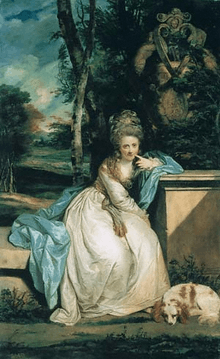Mary Boyle, Countess of Cork and Orrery
| Mary Boyle | |
|---|---|
 Mary Boyle, by Sir Joshua Reynolds, c.1777–1778 | |
| Born |
Mary Monckton 21 May 1746 |
| Died | 30 April 1840 (aged 93) |
| Title | Countess of Cork and Orrery |
| Tenure | 1786-1840 |
| Known for | literary hostess |
| Nationality | British |
Mary Boyle, Countess of Cork and Orrery (21 May 1746 – 30 May 1840) was a British literary hostess.
Life
Born Mary Monckton, she was a daughter of John Monckton, 1st Viscount Galway by his second wife, Jane Westenra of Rathleagh, Queen's County, Ireland.[1]
From her early years, she took a keen interest in literature, and through her influence, her mother's house in London became a favourite meeting place of literary celebrities; Dr Johnson was a frequent guest. Boswell places Mary Monckton among the bluestocking clubs,[2] and writes:
Johnson was prevailed with to come sometimes into these circles, and did not think himself too grave even for the lively Miss Monckton (now Countess of Corke), who used to have the finest bit of blue at the house of her mother, Lady Galway. Her vivacity enchanted the Sage, and they used to talk together with all imaginable ease.[3]
The playwright Richard Brinsley Sheridan was a close friend and regular visitor: in the 1780 general election he stood jointly in the Whig interest with Mary's brother Edward and was elected 2nd Member for Stafford. Reynolds, Burke and Horace Walpole were among her constant visitors, and Mrs Siddons was her closest friend. In 1786, she became the second wife of Edmund Boyle, 7th Earl of Cork and 7th Earl of Orrery. As Lady Cork, her love of social "lions" became more pronounced than ever. Among her regular guests were Canning and Castlereagh, Byron, Sir Walter Scott, Lord John Russell, Sir Robert Peel, Theodore Hook and Sydney Smith. Politically, there was never any doubt of her sympathies: although brother Edward wavered, Mary still signed herself "a True Whig" into old age.[4]
She is supposed to have been the original of Lady Bellair in Disraeli's Henrietta Temple, and Dickens is believed to have drawn on her for some of the peculiarities of Mrs Leo Hunter in The Pickwick Papers. Lady Cork had a remarkable memory, and was a brilliant conversationalist.[2] Several of the historical novels of Georgette Heyer refer to the fame of her literary parties, and the crucial role which wit and good conversation played there: a character remarks that the highest praise a hostess can dream of is to be called "a second Lady Cork".
She died in London on 30 May 1840.[2] She was then ninety-four, but within a few days of her death had been either dining out or entertaining every night. She was buried in Brewood parish church, Staffordshire, close to the estates of her brother, Edward Monckton.[5]
Sources
- Attribution
 This article incorporates text from a publication now in the public domain: Lee, Elizabeth (1894). "Monckton, Mary". In Lee, Sidney. Dictionary of National Biography. 38. London: Smith, Elder & Co.
This article incorporates text from a publication now in the public domain: Lee, Elizabeth (1894). "Monckton, Mary". In Lee, Sidney. Dictionary of National Biography. 38. London: Smith, Elder & Co.  This article incorporates text from a publication now in the public domain: Chisholm, Hugh, ed. (1911). "article name needed". Encyclopædia Britannica (11th ed.). Cambridge University Press.
This article incorporates text from a publication now in the public domain: Chisholm, Hugh, ed. (1911). "article name needed". Encyclopædia Britannica (11th ed.). Cambridge University Press.
